Release Notes for Cisco ASDM, 7.17(x)
This document contains release information for Cisco ASDM Version 7.17(x) for the Cisco ASA series.
Important Notes
-
ASDM signed-image support in 9.17(1.13)/7.18(1.152) and later—The ASA now validates whether the ASDM image is a Cisco digitally signed image. If you try to run an older ASDM image with an ASA version with this fix, ASDM will be blocked and the message “%ERROR: Signature not valid for file disk0:/<filename>” will be displayed at the ASA CLI. ASDM release 7.18(1.152) and later are backwards compatible with all ASA versions, even those without this fix. (CSCwb05291, CSCwb05264)
-
No support for the ASA 5506-X, 5506H-X, 5506W-X, ASA 5508-X, and ASA 5516-X in 9.17(1) and later—ASA 9.16(x) is the last supported version. For the ASA FirePOWER module on the ASA 5508-X and 5516-X, the last supported combination is 9.16/7.0.
-
No support for the ASA FirePOWER module on the ISA 3000 in 9.17(1) and later—The ISA 3000 continues to be supported in ASA 9.17 and later; however, the last supported combination for the ASA FirePOWER module is 9.16/7.0.
-
No support for Clientless SSL VPN in 9.17(1) and later—Clientless SSL VPN is no longer supported.
-
webvpn—The following subcommands are removed:
-
apcf
-
java-trustpoint
-
onscreen-keyboard
-
port-forward
-
portal-access-rule
-
rewrite
-
smart-tunnel
-
-
group-policy webvpn—The following subcommands are removed:
-
port-forward
-
smart-tunnel
-
ssl-clientless
-
-
-
ASDM Upgrade Wizard—Due to an internal change, starting in March 2022 the upgrade wizard will no longer work with pre-ASDM 7.17(1.152) versions. You must manually upgrade to 7.17(1.152) to use the wizard.
-
ASDM 7.18 ending support for Java Web Launch—Starting with ASDM 7.18, ASDM will no longer support Java Web Start due to Oracle’s end of support for JRE 8 and Java Network Launching Protocol (JNLP). You will have to install the ASDM Launcher to launch ASDM.
System Requirements
ASDM requires a computer with a CPU with at least 4 cores. Fewer cores can result in high memory usage.
ASDM Java Requirements
You can install ASDM using Oracle JRE 8.0 (asdm-version.bin) or OpenJRE 1.8.x (asdm-openjre-version.bin).
The Oracle version of ASDM is included in the ASA package; if you want to use the OpenJRE version, you will need to copy it to the ASA and configure the ASA to use that version of ASDM.
 Note |
ASDM is not supported on Linux. |
|
Operating System |
Browser |
Oracle JRE |
OpenJRE |
||||||
|---|---|---|---|---|---|---|---|---|---|
|
Firefox |
Safari |
Chrome |
|||||||
|
Microsoft Windows (English and Japanese):
|
Yes |
No support |
Yes |
8.0 version 8u261 or later |
1.8
|
||||
|
Apple OS X 10.4 and later |
Yes |
Yes |
Yes (64-bit version only) |
8.0 version 8u261 or later |
1.8 |
||||
ASDM Compatibility Notes
The following table lists compatibility caveats for ASDM.
|
Conditions |
Notes |
||
|---|---|---|---|
|
ASDM Launcher compatibility with ASDM version |
"Unable to Launch Device Manager" error message. If you upgrade to a new ASDM version and then get this error, you may need to re-install the latest Launcher.
|
||
|
Windows |
"Java Application blocked" error message. When you launch the ASDM Web Launcher, Oracle might block the application from running and prompt you to set the application's security level. The popup notification includes a link to Java's web page, where workaround steps are provided. 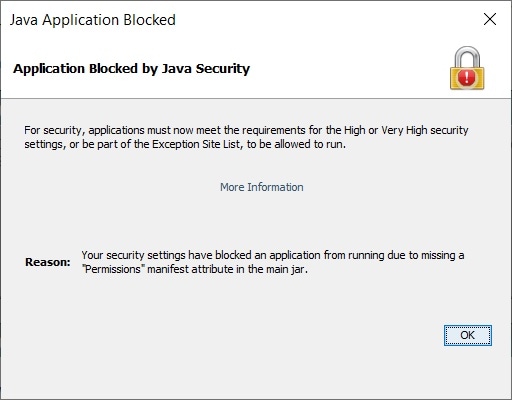 |
||
|
Windows Active Directory directory access |
In some cases, Active Directory settings for Windows users may restrict access to program file locations needed to successfully launch ASDM on Windows. Access is needed to the following directories:
If your Active Directory is restricting directory access, you need to request access from your Active Directory administrator. |
||
|
Windows 10 |
"This app can't run on your PC" error message. When you install the ASDM Launcher, Windows 10 might replace the ASDM shortcut target with the Windows Scripting Host path, which causes this error. To fix the shortcut target:
|
||
|
OS X |
On OS X, you may be prompted to install Java the first time you run ASDM; follow the prompts as necessary. ASDM will launch after the installation completes. |
||
|
OS X 10.8 and later |
You need to allow ASDM to run because it is not signed with an Apple Developer ID. If you do not change your security preferences, you see an error screen. 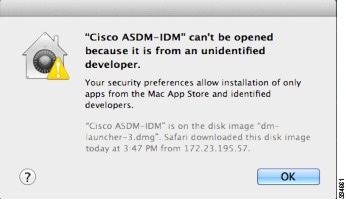
|
||
|
(ASA 5500 and ISA 3000) Requires Strong Encryption license (3DES/AES) on ASA
|
ASDM requires an SSL connection to the ASA. You can request a 3DES PAK license from Cisco:
|
||
|
When the ASA uses a self-signed certificate or an untrusted certificate, Firefox and Safari are unable to add security exceptions when browsing using HTTPS over IPv6. See https://bugzilla.mozilla.org/show_bug.cgi?id=633001. This caveat affects all SSL connections originating from Firefox or Safari to the ASA (including ASDM connections). To avoid this caveat, configure a proper certificate for the ASA that is issued by a trusted certificate authority. |
||
|
If you change the SSL encryption on the ASA to exclude both RC4-MD5 and RC4-SHA1 algorithms (these algorithms are enabled by default), then Chrome cannot launch ASDM due to the Chrome “SSL false start” feature. We suggest re-enabling one of these algorithms (see the pane); or you can disable SSL false start in Chrome using the --disable-ssl-false-start flag according to Run Chromium with flags. |
Install an Identity Certificate for ASDM
When using Java 7 update 51 and later, the ASDM Launcher requires a trusted certificate. An easy approach to fulfill the certificate requirements is to install a self-signed identity certificate.
See Install an Identity Certificate for ASDM to install a self-signed identity certificate on the ASA for use with ASDM, and to register the certificate with Java.
Increase the ASDM Configuration Memory
ASDM supports a maximum configuration size of 512 KB. If you exceed this amount you may experience performance issues. For example, when you load the configuration, the status dialog box shows the percentage of the configuration that is complete, yet with large configurations it stops incrementing and appears to suspend operation, even though ASDM might still be processing the configuration. If this situation occurs, we recommend that you consider increasing the ASDM system heap memory. To confirm that you are experiencing memory exhaustion, monitor the Java console for the "java.lang.OutOfMemoryError" message.
In addition, we recommend reducing your configuration size if possible, for example, by removing unused objects.
Increase the ASDM Configuration Memory in Windows
To increase the ASDM heap memory size, edit the run.bat file by performing the following procedure.
Procedure
|
Step 1 |
Go to the ASDM installation directory, for example C:\Program Files (x86)\Cisco Systems\ASDM. |
|
Step 2 |
Edit the run.bat file with any text editor. |
|
Step 3 |
In the line that starts with “start javaw.exe”, change the argument prefixed with “-Xmx” to specify your desired heap size. For example, change it to -Xmx768M for 768 MB or -Xmx1G for 1 GB. For very large configurations, you may need to specify a heap size up to 2 GB. |
|
Step 4 |
Save the run.bat file. |
Increase the ASDM Configuration Memory in Mac OS
To increase the ASDM heap memory size, edit the Info.plist file by performing the following procedure.
Procedure
|
Step 1 |
Right-click the Cisco ASDM-IDM icon, and choose Show Package Contents. |
|
Step 2 |
In the Contents folder, double-click the Info.plist file. If you have Developer tools installed, it opens in the Property List Editor. Otherwise, it opens in TextEdit. |
|
Step 3 |
Under , change the string prefixed with “-Xmx” to specify your desired heap size. For example, change it to -Xmx768M for 768 MB or -Xmx1G for 1 GB. 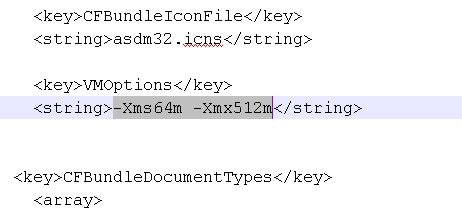 For very large configurations, you may need to specify a heap size up to 2 GB. |
|
Step 4 |
If this file is locked, you see an error such as the following:  |
|
Step 5 |
Click Unlock and save the file. If you do not see the Unlock dialog box, exit the editor, right-click the Cisco ASDM-IDM icon, choose Copy Cisco ASDM-IDM, and paste it to a location where you have write permissions, such as the Desktop. Then change the heap size from this copy. |
ASA and ASDM Compatibility
For information about ASA/ASDM software and hardware requirements and compatibility, including module compatibility, see Cisco ASA Compatibility.
VPN Compatibility
For VPN compatibility, see Supported VPN Platforms, Cisco ASA 5500 Series.
New Features
This section lists new features for each release.
 Note |
New, changed, and deprecated syslog messages are listed in the syslog message guide. |
New Features in ASDM 7.17(1.155)
Released: June 28, 2022
There are no new features in this release.
New Features in ASDM 7.17(1.152)
Released: February 8, 2022
There are no new features in this release.
New Features in ASA 9.17(1)/ASDM 7.17(1)
Released: December 1, 2021
|
Feature |
Description |
|---|---|
|
Platform Features |
|
|
Secure Firewall 3100 |
We introduced the ASA for the Secure Firewall 3110, 3120, 3130, and 3140. The Secure Firewall 3100 supports up to 8 units for Spanned EtherChannel clustering. You can hot swap a network module of the same type while the firewall is powered up without having to reboot; making other module changes requires a reboot. Secure Firewall 3100 25 Gbps interfaces support Forward Error Correction as well as speed detection based on the SFP installed. The SSDs are self-encrypting drives (SEDs), and if you have 2 SSDs, they form a software RAID. New/Modified commands: fec, lacp rate, netmod, speed sfp-detect, raid, show raid, show ssd New/Modified screens: |
|
ASAv support for Autoscale |
The ASAv now supports Autoscale for the following Public Cloud offerings:
Autoscaling increases or decreases the number of ASAv application instances based on capacity requirements. |
|
ASAv for AWS expanded instance support |
The ASAv on the AWS Public Cloud now supports AWS Nitro System instances from different Nitro instance families. ASAv for AWS adds support for these instances:
For a detailed list of supported instances, see the Cisco Adaptive Security Virtual Appliance (ASAv) Data Sheet. |
|
ASAv for Azure expanded instance support |
ASAv on the Azure Public Cloud now supports these instances:
For a detailed list of supported instances, see the Cisco Adaptive Security Virtual Appliance (ASAv) Data Sheet. |
|
Intel QuickAssist Technology (QAT) on ASAv |
The ASAv supports hardware crypto acceleration for ASAv deployments that use the Intel QuickAssist (QAT) 8970 PCI adapter. Hardware crypto acceleration for the ASAv using QAT is supported on VMware ESXi and KVM only. |
|
Single Root I/O Virtualization (SR-IOV) support for ASAv on OCI. |
You can now implement Single Root Input/Output Virtualization (SR-IOV) for ASAv on OCI. SR-IOV can provide performance improvements for ASAv. Mellanox 5 as vNICs are not supported in SR-IOV mode. |
|
Firewall Features |
|
|
Twice NAT support for fully-qualified domain name (FQDN) objects as the translated (mapped) destination |
You can use an FQDN network object, such as one specifying www.example.com, as the translated (mapped) destination address in twice NAT rules. The system configures the rule based on the IP address returned from the DNS server. |
|
Network-service objects and their use in policy-based routing and access control |
You can configure network-service objects and use them in extended access control lists for use in policy-based routing route maps and access control groups. Network-service objects include IP subnet or DNS domain name specifications, and optionally protocol and port specifications, that essentially combine network and service objects. This feature also includes the ability to define trusted DNS servers, to ensure that any DNS domain name resolutions acquire IP addresses from trusted sources. We added or modified the following screens.
|
|
High Availability and Scalability Features |
|
|
ASAv30, ASAv50, and ASAv100 clustering for VMware and KVM |
ASAv clustering lets you group up to 16 ASAvs together as a single logical device. A cluster provides all the convenience of a single device (management, integration into a network) while achieving the increased throughput and redundancy of multiple devices. ASAv clustering supports Individual Interface mode in routed firewall mode; Spanned EtherChannels are not supported. The ASAv uses a VXLAN virtual interface (VNI) for the cluster control link. New/Modified screens: |
|
Clearing routes in a high availability group or cluster |
In previous releases, the clear route command cleared the routing table on the unit only. Now, when operating in a high availability group or cluster, the command is available on the active or control unit only, and clears the routing table on all units in the group or cluster. We changed the clear route command. |
|
Interface Features |
|
|
Geneve interface support for the ASAv |
Geneve encapsulation support was added for the ASAv30, ASAv50, and ASAv100 to support single-arm proxy for the AWS Gateway Load Balancer. New/Modified screens: |
|
Secure Firewall 3100 auto-negotiation can be enabled or disabled for 1Gigabit and higher interfaces. |
Secure Firewall 3100 auto-negotiation can be enabled or disabled for 1Gigabit and higher interfaces. For other model SFP ports, the no speed nonegotiate option sets the speed to 1000 Mbps; the new command means you can set auto-negotiation and speed independently. New/Modified screens:
|
|
Administrative and Troubleshooting Features |
|
|
Startup time and tmatch compilation status |
The show version command now includes information on how long it took to start (boot) up the system. Note that the larger the configuration, the longer it takes to boot up the system. The new show asp rule-engine command shows status on tmatch compilation. Tmatch compilation is used for an access list that is used as an access group, the NAT table, and some other items. It is an internal process that can consume CPU resources and impact performance while in progress, if you have very large ACLs and NAT tables. Compilation time depends on the size of the access list, NAT table, and so forth. |
|
Enhancements to show access-list element-count output and show tech-support content |
The output of the show access-list element-count has be enhanced to show the following:
In addition, the show tech-support output now includes the output show access-list element-count and show asp rule-engine . |
|
CiscoSSH stack |
The ASA uses a proprietary SSH stack for SSH connections. You can now choose to use the CiscoSSH stack instead, which is based on OpenSSH. The default stack continues to be the ASA stack. Cisco SSH supports:
Note that the CiscoSSH stack does not support:
If you need these features, you should continue to use the ASA SSH stack. There is a small change to SCP functionality with the CiscoSSH stack: to use the ASA copy command to copy a file to or from an SCP server, you have to enable SSH access on the ASA for the SCP server subnet/host. New/Modified screens:
|
|
PCAP support in packet tracer |
You can replay a PCAP file in packet tracer tool and obtain the trace results. pcap and force are two new keywords that is used to support the usage of PCAP in packet tracer. New/Modified commands: packet-tracer input and show packet-tracer |
|
Stronger local user and enable password requirements |
For local users and the enable password, the following password requirements were added:
New/Modified screens: |
|
Local user lockout changes |
The ASA can lock out local users after a configurable number of failed login attempts. This feature did not apply to users with privilege level 15. Also, a user would be locked out indefinitely until an admin unlocked their account. Now, users will be unlocked after 10 minutes unless an admin uses the clear aaa local user lockout command before then. Privilege level 15 users are also now affected by the lockout setting. New/Modified commands: aaa local authentication attempts max-fail , show aaa local user |
|
SSH and Telnet password change prompt |
The first time a local user logs into the ASA using SSH or Telnet, they are prompted to change their password. They will also be prompted for the first login after an admin changes their password. If the ASA reloads, however, users will not be prompted even if it is their first login. Note that any service that uses the local user database, such as VPN, will also have to use the new password if it was changed during an SSH or Telnet login. New/Modified commands: show aaa local user |
|
Change in DNS entry TTL behavior |
Formerly, the configured value was added to the existing TTL of each entry (the default was 1 minute). Now, if the expiration timer is longer than the entry's TTL, the TTL is increased to the expire entry time value. If the TTL is longer than the expiration timer, the expire entry time value is ignored; no additional time is added to the TTL in this case. New/Modified screens: |
|
Monitoring Features |
|
|
SNMP now supports IPv6 when grouping multiple hosts in the form of a network object |
The host-group command of snmp-server now supports IPv6 host, range, and subnet objects. |
|
VPN Features |
|
|
Local tunnel id support for IKEv2 |
Support has been added for local Tunnel id configuration for IKEv2. New/Modified commands: set ikev2 local-identity |
|
Support for SAML Attributes with DAP constraint |
Support has been added for SAML assertion attributes which can be used to make DAP policy selections. It also introduces the ability for a group-policy to be specified by the cisco_group_policy attribute. |
|
Multiple SAML trustpoints in IDP configuration |
This feature supports adding multiple IDP trustpoints per SAML IDP configuration for applications that support multiple applications for the same Entity ID. New/Modified commands: saml idp-trustpoint <trustpoint-name> |
|
AnyConnect Client VPN SAML External Browser |
You can now configure VPN SAML External Browser to enable additional authentication choices, such as passwordless authentication, WebAuthN, FIDO2, SSO, U2F, and an improved SAML experience due to the persistence of cookies. When you use SAML as the primary authentication method for a remote access VPN connection profile, you can elect to have the AnyConnect Client use the client’s local browser instead of the AnyConnect Client embedded browser to perform the web authentication. This option enables single sign-on (SSO) between your VPN authentication and other corporate logins. Also choose this option if you want to support web authentication methods, such as biometric authentication and Yubikeys, that cannot be performed in the embedded browser. New/Modified screens: . |
|
VPN Load balancing with SAML |
ASA now supports VPN load balancing with SAML authentication. |
Upgrade the Software
This section provides the upgrade path information and a link to complete your upgrade.
Upgrade Link
To complete your upgrade, see the ASA upgrade guide.
Upgrade Path: ASA Appliances
On the Cisco Support & Download site, the suggested release is marked with a gold star. For example:

View Your Current Version
To view your current version and model, use one of the following methods:
-
ASDM: Choose .
-
CLI: Use the show version command.
Upgrade Guidelines
Be sure to check the upgrade guidelines for each release between your starting version and your ending version. You may need to change your configuration before upgrading in some cases, or else you could experience an outage.
For guidance on security issues on the ASA, and which releases contain fixes for each issue, see the ASA Security Advisories.
Upgrade Paths
This table provides upgrade paths for ASA.
 Note |
ASA 9.16 was the final version for the ASA 5506-X, 5508-X, and 5516-X. ASA 9.14 was the final version for the ASA 5525-X, 5545-X, and 5555-X. ASA 9.12 was the final version for the ASA 5512-X, 5515-X, 5585-X, and ASASM. ASA 9.2 was the final version for the ASA 5505. ASA 9.1 was the final version for the ASA 5510, 5520, 5540, 5550, and 5580. |
|
Current Version |
Interim Upgrade Version |
Target Version |
|---|---|---|
|
9.16 |
— |
Any of the following: → 9.17 |
|
9.15 |
— |
Any of the following: → 9.17 → 9.16 |
|
9.14 |
— |
Any of the following: → 9.17 → 9.16 |
|
9.13 |
— |
Any of the following: → 9.17 → 9.16 |
|
9.12 |
— |
Any of the following: → 9.17 → 9.16 |
|
9.10 |
— |
Any of the following: → 9.17 → 9.16 → 9.12 |
|
9.9 |
— |
Any of the following: → 9.17 → 9.16 → 9.12 |
|
9.8 |
— |
Any of the following: → 9.17 → 9.16 → 9.12 |
|
9.7 |
— |
Any of the following: → 9.17 → 9.16 → 9.12 |
|
9.6 |
— |
Any of the following: → 9.17 → 9.16 → 9.12 |
|
9.5 |
— |
Any of the following: → 9.17 → 9.16 → 9.12 |
|
9.4 |
— |
Any of the following: → 9.17 → 9.16 → 9.12 |
|
9.3 |
— |
Any of the following: → 9.17 → 9.16 → 9.12 |
|
9.2 |
— |
Any of the following: → 9.17 → 9.16 → 9.12 |
|
9.1(2), 9.1(3), 9.1(4), 9.1(5), 9.1(6), or 9.1(7.4) |
— |
Any of the following: → 9.12 |
|
9.0(2), 9.0(3), or 9.0(4) |
— |
Any of the following: → 9.12 |
Upgrade Path: ASA on Firepower 2100 in Platform Mode
To view your current version and model, use one of the following methods:
-
ASDM: Choose .
-
CLI: Use the show version command.
This table provides upgrade paths for the ASA on the Firepower 2100 in Platform mode. Some versions require an intermediate upgrade before you can upgrade to a newer version. Recommended versions are in bold.
Be sure to check the upgrade guidelines for each release between your starting version and your ending version. You may need to change your configuration before upgrading in some cases, or else you could experience an outage.
For guidance on security issues on the ASA, and which releases contain fixes for each issue, see the ASA Security Advisories.
|
Current Version |
Interim Upgrade Version |
Target Version |
|---|---|---|
|
9.16 |
— |
Any of the following: → 9.17 |
|
9.15 |
— |
Any of the following: → 9.17 → 9.16 |
|
9.14 |
— |
Any of the following: → 9.17 → 9.16 → 9.15 |
|
9.13 |
— |
Any of the following: → 9.17 → 9.16 → 9.15 → 9.14 |
|
9.12 |
— |
Any of the following: → 9.17 → 9.16 → 9.15 → 9.14 |
|
9.10 |
— |
Any of the following: → 9.17 → 9.16 → 9.15 → 9.14 → 9.12 |
|
9.9 |
— |
Any of the following: → 9.17 → 9.16 → 9.15 → 9.14 → 9.12 |
|
9.8 |
— |
Any of the following: → 9.17 → 9.16 → 9.15 → 9.14 → 9.12 |
Upgrade Path: ASA Logical Devices for the Firepower 4100/9300
-
FXOS: From FXOS 2.2.2 and later, you can upgrade directly to any higher version. (FXOS 2.0.1–2.2.1 can upgrade as far as 2.8.1. For versions earlier than 2.0.1, you need to upgrade to each intermediate version.) Note that you cannot upgrade FXOS to a version that does not support your current logical device version. You will need to upgrade in steps: upgrade FXOS to the highest version that supports your current logical device; then upgrade your logical device to the highest version supported with that FXOS version. For example, if you want to upgrade from FXOS 2.2/ASA 9.8 to FXOS 2.13/ASA 9.19, you would have to perform the following upgrades:
-
FXOS 2.2 → FXOS 2.11 (the highest version that supports 9.8)
-
ASA 9.8 → ASA 9.17 (the highest version supported by 2.11)
-
FXOS 2.11 → FXOS 2.13
-
ASA 9.17 → ASA 9.19
-
-
FTD: Interim upgrades may be required for FTD, in addition to the FXOS requirements above. For the exact upgrade path, refer to the FMC upgrade guide for your version.
-
ASA: ASA lets you upgrade directly from your current version to any higher version, noting the FXOS requirements above.
|
FXOS Version |
Model |
ASA Version |
FTD Version |
||||
|---|---|---|---|---|---|---|---|
|
2.16 |
Firepower 4112 |
9.17 |
7.6 (recommended) 7.4 7.3 7.2 7.1 |
||||
|
Firepower 4145 Firepower 4125 Firepower 4115 |
9.17 |
7.6 (recommended) 7.4 7.3 7.2 7.1 |
|||||
|
Firepower 9300 SM-56 Firepower 9300 SM-48 Firepower 9300 SM-40 |
|||||||
|
2.14(1) |
Firepower 4112 |
9.17 9.16 9.14 |
7.4 (recommended) 7.3 7.2 7.1 7.0 6.6 |
||||
|
Firepower 4145 Firepower 4125 Firepower 4115 |
9.17 9.16 9.14 |
7.4 (recommended) 7.3 7.2 7.1 7.0 6.6 |
|||||
|
Firepower 9300 SM-56 Firepower 9300 SM-48 Firepower 9300 SM-40 |
|||||||
|
2.13 |
Firepower 4112 |
9.17 9.16 9.14 |
7.3 (recommended) 7.2 7.1 7.0 6.6 |
||||
|
Firepower 4145 Firepower 4125 Firepower 4115 |
9.17 9.16 9.14 |
7.3 (recommended) 7.2 7.1 7.0 6.6 |
|||||
|
Firepower 9300 SM-56 Firepower 9300 SM-48 Firepower 9300 SM-40 |
|||||||
|
2.12 |
Firepower 4112 |
9.17 9.16 9.14 |
7.2 (recommended) 7.1 7.0 6.6 |
||||
|
Firepower 4145 Firepower 4125 Firepower 4115 |
9.17 9.16 9.14 9.12 |
7.2 (recommended) 7.1 7.0 6.6 6.4 |
|||||
|
Firepower 9300 SM-56 Firepower 9300 SM-48 Firepower 9300 SM-40 |
|||||||
|
Firepower 4150 Firepower 4140 Firepower 4120 Firepower 4110 |
9.17 9.16 9.14 9.12 |
7.2 (recommended) 7.1 7.0 6.6 6.4 |
|||||
|
Firepower 9300 SM-44 Firepower 9300 SM-36 Firepower 9300 SM-24 |
|||||||
|
2.11 |
Firepower 4112 |
9.17 (recommended) 9.16 9.14 |
7.1 (recommended) 7.0 6.6 |
||||
|
Firepower 4145 Firepower 4125 Firepower 4115 |
9.17 (recommended) 9.16 9.14 9.12 |
7.1 (recommended) 7.0 6.6 6.4 |
|||||
|
Firepower 9300 SM-56 Firepower 9300 SM-48 Firepower 9300 SM-40 |
|||||||
|
Firepower 4150 Firepower 4140 Firepower 4120 Firepower 4110 |
9.17 (recommended) 9.16 9.14 9.12 9.8 |
7.1 (recommended) 7.0 6.6 6.4 |
|||||
|
Firepower 9300 SM-44 Firepower 9300 SM-36 Firepower 9300 SM-24 |
|||||||
|
2.10
|
Firepower 4112 |
9.16 (recommended) 9.14 |
7.0 (recommended) 6.6 |
||||
|
Firepower 4145 Firepower 4125 Firepower 4115 |
9.16 (recommended) 9.14 9.12 |
7.0 (recommended) 6.6 6.4 |
|||||
|
Firepower 9300 SM-56 Firepower 9300 SM-48 Firepower 9300 SM-40 |
|||||||
|
Firepower 4150 Firepower 4140 Firepower 4120 Firepower 4110 |
9.16 (recommended) 9.14 9.12 9.8 |
7.0 (recommended) 6.6 6.4 |
|||||
|
Firepower 9300 SM-44 Firepower 9300 SM-36 Firepower 9300 SM-24 |
|||||||
|
2.9 |
Firepower 4112 |
9.14 |
6.6 |
||||
|
Firepower 4145 Firepower 4125 Firepower 4115 |
9.14 9.12 |
6.6 6.4 |
|||||
|
Firepower 9300 SM-56 Firepower 9300 SM-48 Firepower 9300 SM-40 |
|||||||
|
Firepower 4150 Firepower 4140 Firepower 4120 Firepower 4110 |
9.14 9.12 9.8 |
6.6 6.4 |
|||||
|
Firepower 9300 SM-44 Firepower 9300 SM-36 Firepower 9300 SM-24 |
|||||||
|
2.8 |
Firepower 4112 |
9.14 |
6.6
|
||||
|
Firepower 4145 Firepower 4125 Firepower 4115 |
9.14 (recommended) 9.12
|
6.6 (recommended)
6.4 |
|||||
|
Firepower 9300 SM-56 Firepower 9300 SM-48 Firepower 9300 SM-40 |
|||||||
|
Firepower 4150 Firepower 4140 Firepower 4120 Firepower 4110 |
9.14 (recommended) 9.12 9.8 |
6.6 (recommended)
6.4 6.2.3 |
|||||
|
Firepower 9300 SM-44 Firepower 9300 SM-36 Firepower 9300 SM-24 |
|||||||
|
2.6(1.157)
|
Firepower 4145 Firepower 4125 Firepower 4115 |
9.12
|
6.4 |
||||
|
Firepower 9300 SM-56 Firepower 9300 SM-48 Firepower 9300 SM-40 |
|||||||
|
Firepower 4150 Firepower 4140 Firepower 4120 Firepower 4110 |
9.12 (recommended) 9.8 |
6.4 (recommended) 6.2.3 |
|||||
|
Firepower 9300 SM-44 Firepower 9300 SM-36 Firepower 9300 SM-24 |
|||||||
|
2.6(1.131) |
Firepower 9300 SM-48 Firepower 9300 SM-40 |
9.12 |
Not supported |
||||
|
Firepower 4150 Firepower 4140 Firepower 4120 Firepower 4110 |
9.12 (recommended) 9.8 |
||||||
|
Firepower 9300 SM-44 Firepower 9300 SM-36 Firepower 9300 SM-24 |
|||||||
|
2.3(1.73) |
Firepower 4150 Firepower 4140 Firepower 4120 Firepower 4110 |
9.8
|
6.2.3 (recommended)
|
||||
|
Firepower 9300 SM-44 Firepower 9300 SM-36 Firepower 9300 SM-24 |
|||||||
|
2.3(1.66) 2.3(1.58) |
Firepower 4150 Firepower 4140 Firepower 4120 Firepower 4110 |
9.8
|
|||||
|
Firepower 9300 SM-44 Firepower 9300 SM-36 Firepower 9300 SM-24 |
|||||||
|
2.2 |
Firepower 4150 Firepower 4140 Firepower 4120 Firepower 4110 |
9.8 |
FTD versions are EoL |
||||
|
Firepower 9300 SM-44 Firepower 9300 SM-36 Firepower 9300 SM-24 |
Note on Downgrades
Downgrade of FXOS images is not officially supported. The only Cisco-supported method of downgrading an image version of FXOS is to perform a complete re-image of the device.
Open and Resolved Bugs
The open and resolved bugs for this release are accessible through the Cisco Bug Search Tool. This web-based tool provides you with access to the Cisco bug tracking system, which maintains information about bugs and vulnerabilities in this product and other Cisco hardware and software products.
 Note |
You must have a Cisco.com account to log in and access the Cisco Bug Search Tool. If you do not have one, you can register for an account. If you do not have a Cisco support contract, you can only look up bugs by ID; you cannot run searches. |
For more information about the Cisco Bug Search Tool, see the Bug Search Tool Help & FAQ.
Open Bugs
This section lists open bugs in each version.
Open Bugs in Version 7.17(1.155)
The following table lists select open bugs at the time of this Release Note publication.
|
Identifier |
Headline |
|---|---|
|
Appliance mode : checksum does not match issue while downloading asa image from CCO |
|
|
Check box not available for disable delete tunnel with no delay in simultaneous connection prempt |
|
|
Cipher changes require in VPN wizard according to 9161/7161 CLIs |
Open Bugs in Version 7.17(1.152)
The following table lists select open bugs at the time of this Release Note publication.
|
Identifier |
Headline |
|---|---|
|
Appliance mode : checksum does not match issue while downloading asa image from CCO |
|
|
Check box not available for disable delete tunnel with no delay in simultaneous connection prempt |
|
|
Cipher changes require in VPN wizard according to 9161/7161 CLIs |
Open Bugs in Version 7.17(1)
The following table lists select open bugs at the time of this Release Note publication.
|
Caveat ID Number |
Description |
|---|---|
|
Appliance mode : checksum does not match issue while downloading asa image from CCO |
|
|
ASDM: Need support for MAC in Launcher 1.9.1 |
|
|
Check box not available for disable delete tunnel with no delay in simultaneous connection prempt |
|
|
Cipher changes require in VPN wizard according to 9161/7161 CLIs |
Resolved Bugs
This section lists resolved bugs per release.
Resolved Bugs in Version 7.17(1.155)
The following table lists select resolved bugs at the time of this Release Note publication.
|
Identifier |
Headline |
|---|---|
|
ASA: Cannot connect to ASA using ASDM with Java Web Launch |
Resolved Bugs in Version 7.17(1.152)
The following table lists select resolved bugs at the time of this Release Note publication.
|
Identifier |
Headline |
|---|---|
|
ASDM: Need support for MAC in Launcher 1.9.1 |
|
|
ASDM side changes for the ASA #CSCvz89126 |
Resolved Bugs in Version 7.17(1)
The following table lists select resolved bugs at the time of this Release Note publication.
|
Caveat ID Number |
Description |
|---|---|
|
NSF wait interval warning popup is not showing when configuring wrong value |
|
|
ASDM Display "n/a" for "Peak Usage (KB)" Under Tab "Context Usage" of Memory Status |
|
|
ASA Cluster ASDM real-time log viewer showing same events on Master and Slave |
|
|
ASDM session being abruptly terminated when switching between different admin and system contexts |
|
|
Hostscan 4.3.x to 4.6.x Migration steps should not be display when the SDM have the HS 4.10.x |
|
|
ASDM does not recognize SCTP port as per the parser Errors |
|
|
"load balancing" item is not displayed on ASDM. |
|
|
ASDM: Transforms file name must start with "_" underscore to take effect to multiple AC modules |
|
|
ASA: Multiple context mode : ASDM logging stops, when switched to a different context |
Cisco General Terms
The Cisco General Terms (including other related terms) governs the use of Cisco software. You can request a physical copy from Cisco Systems, Inc., P.O. Box 641387, San Jose, CA 95164-1387. Non-Cisco software purchased from Cisco is subject to applicable vendor license terms. See also: https://cisco.com/go/generalterms.
Related Documentation
For additional information on the ASA, see Navigating the Cisco ASA Series Documentation.
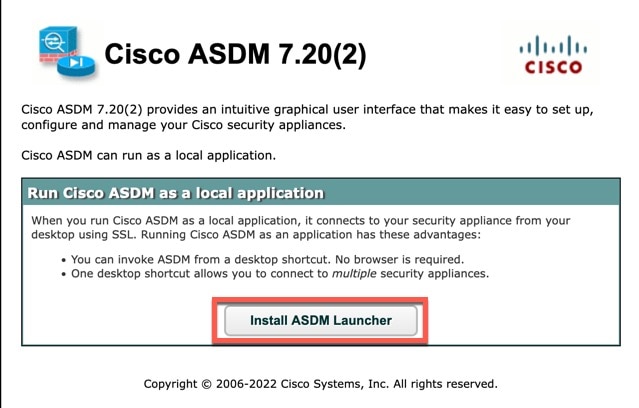
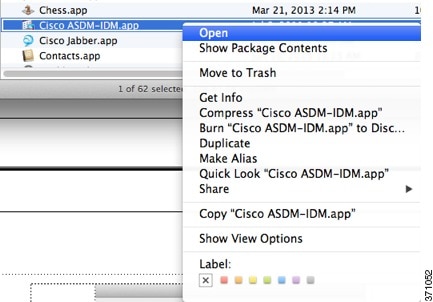
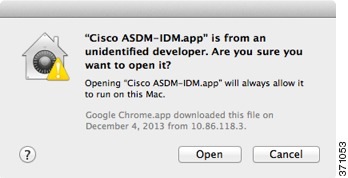
 Feedback
Feedback